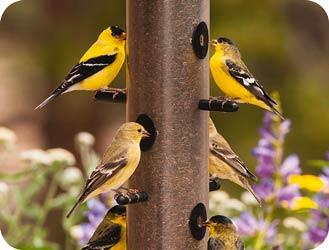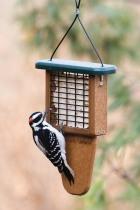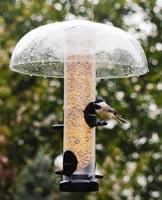Feeding Birds in Winter
The Busy Season for Flocking Seed-Eaters
 Although we have goldfinches here all year-round, the winter months see clearly more activity at feeders. We typically see the first signs of an increase in goldfinch appetite in September, with generally higher level of action from October through April. There are several causes of this: spring and summer nesting causes big feeding flocks to disperse into pairs before the reforming of flocks in fall, there is less natural food available during the winter months, and we see overall numbers swelled by migrating American goldfinches and pine siskins in winter. Read more about attracting goldfinches.
Although we have goldfinches here all year-round, the winter months see clearly more activity at feeders. We typically see the first signs of an increase in goldfinch appetite in September, with generally higher level of action from October through April. There are several causes of this: spring and summer nesting causes big feeding flocks to disperse into pairs before the reforming of flocks in fall, there is less natural food available during the winter months, and we see overall numbers swelled by migrating American goldfinches and pine siskins in winter. Read more about attracting goldfinches.
These birds are some of the mainstays of any birdfeeding station, so the main practical conclusion is simple: keep feeding them! With finch feeders offering the tiny black seed called Nyjer or thistle, you may need to refresh your seed if it grew stale during the slow summer months. All the finch species will also eat hulled sunflower as found in our No-Mess Blend.
When it Gets Cold: Offer Suet and Feed the Insect-Eaters
 At some point, even California gets cooler - and since birds don't have warm coats to pull on and central heating to retreat to, that means that they're burning extra calories each night just to maintain their body temperature and survive. The best foods for calorie replacement are fatty suet cakes and our spreadable peanut-flavored suet Bark Butter.
At some point, even California gets cooler - and since birds don't have warm coats to pull on and central heating to retreat to, that means that they're burning extra calories each night just to maintain their body temperature and survive. The best foods for calorie replacement are fatty suet cakes and our spreadable peanut-flavored suet Bark Butter.
In addition to increasing most birds' desire for fatty foods, cold weather particular impacts insect-eating birds. When cold hits, much of their insect prey dies, leaving birds like Townsend's and Yellow-rumped Warblers, Hermit Thrushes, Kinglets, Bushtits, and Northern Flickers less picky about visiting feeders. All of these birds are uncommon feeder visitors in our area, but all have been reported in winter at suet or mealworm feeders.
If night temperatures drop below freezing, finding morning water can also become more difficult. Filling a birdbath with fresh water in the morning will be attractive to many birds, including many of these winter insect-eaters who rarely visit feeders: robins, flickers, bluebirds, and our winter warblers will readily visit a birdbath.
When it Gets Wet: Keep Seed Drier
 How well bird food survives wet weather depends on several factors: how much rain we get, how fast the birds eat, the food type, and the feeder type. Water itself will not harm birds, so if your food is being consumed rapidly when rain arrives, you may be spared most extra maintenance if the birds are able to empty the feeder within the next day or so. What you want to avoid is an excess of food getting wet and sitting out for an extended period, so the first and most universal advice is to keep an eye on your feeders and use some common sense: if the seed is caking together or visibly molding, you clearly have a problem and should clean out your feeders and refill with fresh seed.
How well bird food survives wet weather depends on several factors: how much rain we get, how fast the birds eat, the food type, and the feeder type. Water itself will not harm birds, so if your food is being consumed rapidly when rain arrives, you may be spared most extra maintenance if the birds are able to empty the feeder within the next day or so. What you want to avoid is an excess of food getting wet and sitting out for an extended period, so the first and most universal advice is to keep an eye on your feeders and use some common sense: if the seed is caking together or visibly molding, you clearly have a problem and should clean out your feeders and refill with fresh seed.
Weather Domes are one very useful tool for keeping seed drier. We have multiple sizes, including tight-fitting domes made specifically to go with our Wild Birds Unlimited tube feeders, or domes with universal hooks that can be used with nearly any hanging feeder.
Another important thing to consider is your choice of finch feeder. Mesh feeders, whether made of soft fabric or metal, offer minimal weather protection - rain goes right through them! Finch feeders with solid tubes and small holes specifically for Nyjer don't let in much rain. If you haven't been seeing any finches on your feeder recently and your seed has been sitting outside since getting wet, you probably need to put fresh seed out. Learn more about choosing a finch feeder in our Attracting Goldfinches article.
Suet feeders (particularly with lids) and hummingbird feeders are additional good, low maintenance feeder options that survive rain relatively well.
Sparrows: Our Major Winter Visitors
|
First-winter White-crowned Sparrow |
The most obvious of our autumn arrivals are the sparrows: White-crowned and Golden-crowned are abundant, while you may also see Fox, White-throated, or even Lincoln's Sparrows looking for seeds in your yard. All of these, however, are primarily ground-feeding birds that are less comfortable on clinging-style feeders or feeders with small perches.
Offering food in separate tray feeders with a broad feeding platform is one option to make your yard more sparrow friendly. Many tube style seed feeders can also be fitted with an add-on tray which both prevents seed from falling to the ground and provides a more ground-feeder friendly feeding area. You might also consider your seed blend: having some millet, such as in our No-Mess Blend, is often a good winter option, as this seed is favored by sparrows and ground-feeding birds. Most of the small perching birds will choose the nuts and sunflower, allowing the millet to be gradually released to the ground for other birds.
Read more about our winter sparrows on the blog.


